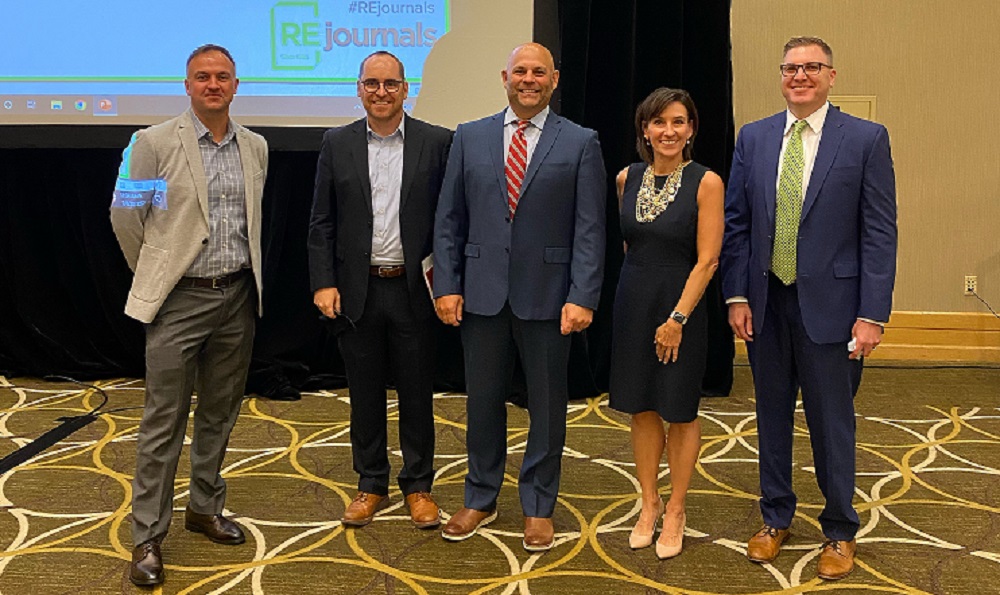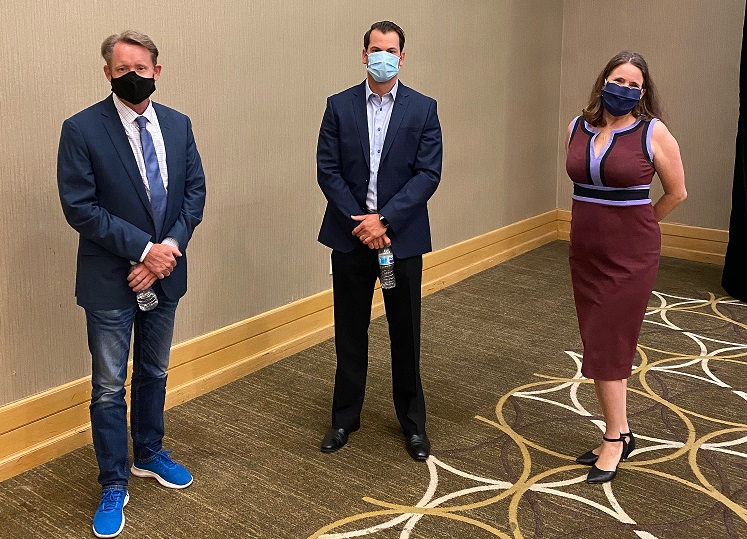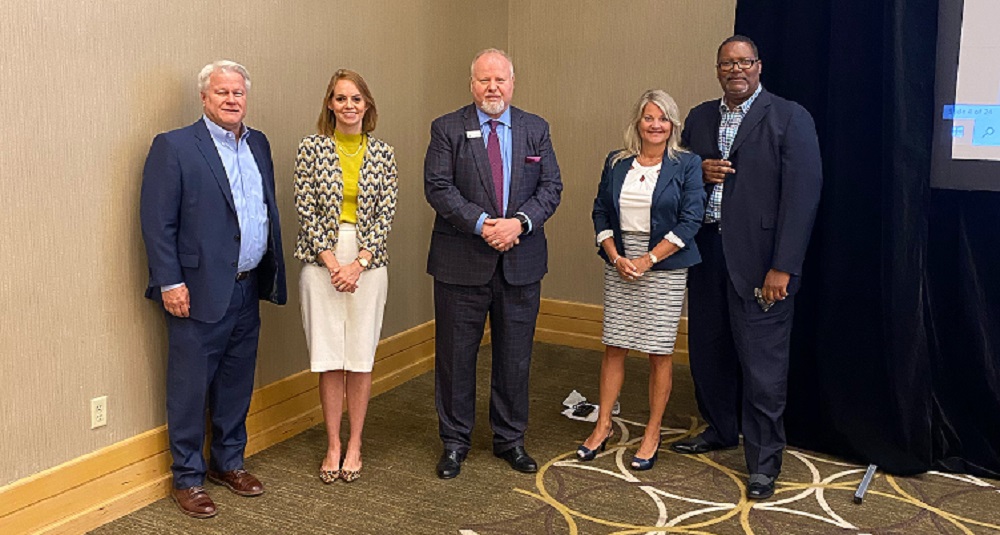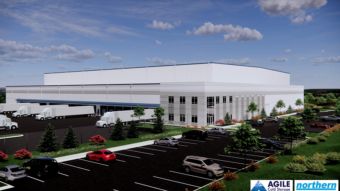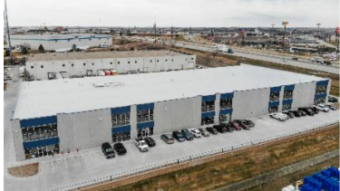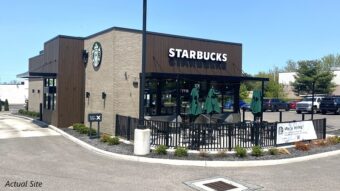Sarah Hempstead, chief executive officer of Indianapolis-based architecture and engineering firm Schmidt Associates, asked the attendees at the 4th Annual Indianapolis Commercial Real Estate Summit the obvious question: Was this summit the first industry event they’ve attended in-person since the COVID-19 pandemic swept through the country?
To little surprise, nearly every person in the audience raised his or her hands.
Those attendees at the Westin Indianapolis on July 8 sat socially distanced from each other at tables spaced carefully throughout the room, with chairs spread out to prevent audience members from sitting too close. They wore masks, too. Some of the event’s speakers attended remotely while some sat at a table in front of the room, maintaining at least six feet of distance from each other.
And while many attendees made the trek to the Westin, others watched from home, observing the Indianapolis summit as a webinar.
Yes, it was an Indianapolis Commercial Real Estate Summit like none other in the four-year history of the event. But while the handshakes and hugs of previous summits were gone, the hope was not. The key word throughout the day? Resilience.
Speakers repeatedly pointed to the resilience of Indianapolis as a reason for hope. Yes, businesses are struggling and residents are nervous, with everyone keeping a close eye on new COVID cases. But the city of Indianapolis is still working, commercial deals are still closing and the days when the city is past this crisis look bright, speakers said.
Craig Von Deylen, president and principal of Deylen Realty, Inc., summed this up nicely during the Apartment Market Update & Forecast panel.
“I am very encouraged by the resiliency of business owners,” Von Deylen said. “We have not lost very many businesses. Business owners are rolling up their sleeves to do whatever they can to reopen and survive this. That’s important. We have that type of environment here. I want to continue to develop properties in that kind of environment. We are going to work our asses off.”
Angela Smith Jones, deputy mayor of economic development for the city of Indianapolis, kicked off the summit with her keynote speech. Jones emphasized that though COVID-19 has certainly hurt Indianapolis and its business community, that the city will emerge from the pandemic strong and united.
She, too, focused on the resiliency of the city, saying that business owners and municipal leaders are working together to fight through the pandemic.
As is the tradition at the CRE summits that Midwest Real Estate News holds throughout the year, the Indianapolis event featured three panels loaded with some of the biggest names in the city’s commercial real estate industry.
The multifamily panel featured Von Deylen, president and principal of Deylen Realty, Inc.; RJ Pasquesi, founder and president of KCG Companies; moderator Sarah Hempstead, chief executive officer of Schmidt Associates, Inc.; Steve LaMotte Jr., executive vice president of CBRE Indianapolis/Louisville multifamily; and Josh Caruana, vice president and managing broker with Marcus & Millichap.
The Market Update Panel featured plenty of big names in the Indianapolis commercial real estate industry. Speaking on this panel were Keith Stark, founder and chief executive officer of ConsortiumCRE; moderator Sarah Evans, landscape architect with V3 Companies; Sam Smith, principal and chairman of RESOURCE and president of the CCIM Indiana chapter; Rebecca Wells, principal, capital markets and investment sales with Lee & Associates; Gary Hobbs, chief executive officer of BWI; and Joseph DiSalvo, senior vice president of investments with Marcus & Millichap.
The Game Changers panel, focusing on new development in the Indianapolis market, was another highlight of the summit. Speaking on this panel were Gavin Thomas, vice president of development with Hendricks Commercial Properties; Andy Mallon, executive director of the Capital Improvement Board of Managers of Marion County; Ryan Gallmeyer, vice president for production with Buckingham Companies; Angela Wethington, director with Scannell Properties; and moderator David Adams, partner with the real estate and environmental practice with Krieg DeVault LLP.
These panelists didn’t sugarcoat the challenges that Indianapolis faces. But they also offered hope.
LaMotte from CBRE, for instance, pointed to the resiliency shown so far by the multifamily sector in Indianapolis.
“The collections train wreck didn’t materialize,” LaMotte said. “We didn’t see a fall-off in collections or a significant drop-off in traffic. Retention rates in apartments have actually increased. That has all been unexpected.”
LaMotte said that the higher retention rates have been a pleasant surprise. As he said, renters haven’t chosen to move during the pandemic. They are staying put, helping to ease any financial hits on apartment owners.
At the same time, investors haven’t abandoned the apartment market in Indianapolis, LaMotte said.
“We are seeing flow and investment capital back into the market,” he said. “Capital is coming back. I think what we’ll see when we come out of this is that multifamily, along with logistics, will be perceived as the safe harbors of commercial real estate.”
Pasquesi of KCG Companies said that the pandemic will bring some long-lasting changes to the apartment market. He said that the state-ordered shutdowns across the country might spur more interest in suburban living, where renters can enjoy additional living space and more outdoor amenities.
The amenities that come with urban living, the nearby restaurants, theaters and night life, aren’t that impressive when these businesses are shut down.
“A lot of people will worry about what happens if we have to quarantine again,” Pasquesi said. “They did not enjoy doing that in their high-rises in dense, urban areas. There might be an exodus to suburban areas. People want more space.”
Pasquesi said, too, that architects and developers might feel pressure now to make apartments more flexible and units larger. The trend might move away from the recent focus on providing more common-area amenities and shift back toward offering renters more spacious units.
“When you are asked to stay at home, your apartment is now your office. It is now your gym,” Pasquesi said. “How do you make apartment space more flexible in case this happens again?”
LaMotte, though, said that the future still remains bright for urban apartment living. People were flocking to apartment buildings in the center of cities before the pandemic hit. LaMotte said that not even COVID-19 will put a halt to this trend.
“The pendulum might be swinging a bit to the suburban side today,” LaMotte said. “But once a vaccine becomes available memories will tend to fade. We’ll see people losing that mindset of being concerned whenever they step in an elevator. Those fears fade over time. There is so much energy in downtown Indianapolis and nearly every other downtown area across the country. We can’t stay in this fear mindset forever.”
Caruana from Marcus & Millichap said that Indianapolis will remain the type of steady, safe market that attracts investors. Before COVID, Caruana said, investors will buying into Indianapolis’ stability factor.
“When we get through this crisis, we will see a continuation of that,” Caruana said. “The markets like Indianapolis are high-quality. We will still be a favorite of investors. There will be a temporary pause until we get back to full steam. The question is whether it is a three-month pause or a six-month pause. We just don’t know that yet.”
Panelists said that the other markets in Indianapolis — office, retail and industrial — are going through their own challenges, with some sectors facing more struggles than others.
DiSalvo, with Marcus & Millichap, said that there is still activity and deals are still closing in the Indianapolis office market, for instance, even though this deal flow has slowed since the pandemic hit.
“We have weathered the storm better than a lot of people expected,” DiSalvo said. “There will be companies that don’t need as much office space now. But there will still be a demand for office space in Indianapolis. I know that I can’t be as productive working from home. You lose a lot of that collaboration. I don’t think the office is a thing of the past. It has changed, but that change isn’t nearly as profound as some people say.”
Stark, from ConsortiumCRE, said that the retail sector has been decimated by COVID-19. There is no way around that. And measures such as the Paycheck Protection Program aren’t enough to get many restaurants and stores through this pandemic, he said.
“It’s like a hockey game. Retail is in the penalty box. Retail doesn’t even get to play right now. Restaurants don’t get to play,” Stark said. “While some industries have seen a lesser dip, retail has been decimated. This year was looking to be the strongest year I ever had in terms of square footage, in terms of dollars. But this pandemic just lopped off the first six months of the year. Going around the state, there aren’t too many retail success stories. Most people are hanging on by a shoestring.”
Smith from RESOURCE said that most commercial real estate sectors still face daunting challenges because of the pandemic. He said that the federal government’s stimulus checks and extended unemployment benefits have blunted some of the damage so far. But these are just band-aid fixes, Smith said.
“I think the stimulus is temporarily masking more serious problems,” he said. “This is all about jobs. It is all about the small businesses that face bankruptcy. There has been an artificial shield from the federal government and Federal Reserve. The sky is falling in some sectors such as retail and assisted living.”
Wells from Lee & Associates said the impact of COVID-19 has varied widely depending on the commercial sector. She said that all of her pending office deals have been put on hold. And in the future? She sees a boost for suburban office space and, perhaps, a slight dip in demand for office space in the city’s CBD.
The industrial market, though, continues to chug along, Wells said.
“We are fortunate to have some of the strongest industrial developers in the country right here in Indianapolis,” Wells said. “Indianapolis is a top-10 or top-12 industrial market. It is very strong. That provides hope for me. Industrial is still happening here, even during the pandemic.”
Of course, COVID-19 isn’t the only challenge that Indianapolis faces. Like all cities across the country, Indianapolis is taking a closer look at race relations and the relations between its police officers and its African American community as Black Lives Matter protests continue across the United States.
This topic was particularly relevant for Hobbs from BWI. Hobbs is African American, working in an industry that is still dominated by white men. This a challenge that many people who aren’t minorities don’t understand, Hobbs said.
He told a story of appearing at a municipal board meeting to pitch one of his company’s developments. During the city meeting — not in Indianapolis, Hobbs said — a resident stood up and told Hobbs that he was tired of “you people.”
“He was speaking to me,” Hobbs said. “When I go to a community and they don’t like the project, they try to defame me personally and my business. That is an additional challenge that other people don’t face.”
Commercial real estate businesses in Indianapolis need to hire more African Americans, Hobbs said. And more commercial development needs to happen in neighborhoods that have higher minority populations, he said.
And white people need to be involved in these efforts.
“If my white colleagues say something, it carries more weight than it does when I say something,” Hobbs said. “You have to say something. You have to hire more people of color. Those are things that each of us can do to provide healing in our city and state.”
